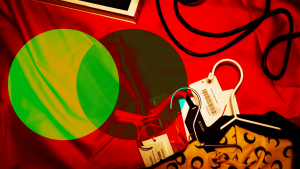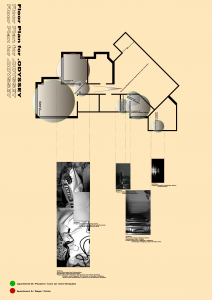

Bryan Wong Hon Ting 3035574983
Description/ Abstract
In most time of our evolution, conflict perpetuates the transcendence of civilization. Kubrick’s rendition for this phenomenon is represented by a monolith. Once again, as we are currently experiencing the unforeseen conflict through threats of the pandemic, there should be a more literal (or blatant) way of expression to what might be its prophecy. Is this the doomsday of mankind? Or is this the interim for contemplation and resurgence?
On a course of isolation, one must be aware of the being, with a burden of weight, shall it stumble and provoke selfishness. Now that nations are consuming anti-globalization, we are in the phase of welcoming a new dawn. The art of globalization is the art of crisis. Globalization is at our subconscious that provokes the minds of self, protection, or centralization. And this is where it has led us to. It’s only the curator’s fault to be blamed, which is us. As mediocre as it could be, a neighborhood confrontation (virtually or isolated/ separated by doors) is a miniature of what globalization’s aftermath is telling us.
Throughout the minutes of the clip, the protagonist consumes globalization through forms of eatery, media, sound, fashion, iconographies, and books. When globalization enhanced the connectivity of the world, everything comes and goes at a mere blink of an eye all of a sudden. Sarcastically, we vowed to surrender parts of our sovereignty for the acceptance of a shared community, but because of that, we are overall ruled by the joy of global products that we have almost overlooked or neglected the needs of taking a look back at ourselves and the ones beside you (in this case within the sequence, the protagonist’s neighbor that is bout to drive crazy).
This isn’t just a uni-directional criticism, but its more of a vice versa circumstances. As seen in the sequence, the neighbor (semi-victim as he’s annoyed by the noise and laughter by the protagonist) deals with his mental anger through smoking, these smokes then flows towards the apartment and goes into the protagonist space. Again, even if we are victimized by one’s annoyance, globalization taught us to deal with these problems by obstructing it through another form of consumption. It does not necessarily relate to an absolute true or false whether its as critical as “crisis” as mentioned on a small scale. But treating consumption as a paradigm will start to broaden this idea to a larger scale if everyone is underestimating the idea of personal selfishness OR one deals with their annoyance through forms of consumption, they add up to an intangible “crisis”.
As the idea of consumption is just as common as everyone in the world, the protagonist is seen by a profile shadow, and the neighbor is presented through works of POV. In a way, the neighbor could be you or the protagonist, and we switch roles all the time as much as it’s like a chain reaction.
In another word, this is just the reason for the outbreak of corona. If 2020 is told to be red, 2021 will be green.
References included in the credit scene in the video
A very experimental approach on conveying the emotions of being trapped within the apartment during the COVID-19 quarantine. In terms of content, subjects of investigation are elaborately shown on the screen. Bag of snacks, clothes with hangers, a stove, a cigarette, glances of these subjects are presented with an ornament of shots correlating them to the architecture itself. This could effectively accentuate the narrative of these objects within the apartment, alongside a slight touch of colour adjustment, articulating the emotions conveyed. On the technical side, the high contrast in colour and lighting are both promising in conveying the emotions towards the quarantine life. The transition of filters could also present the attitude towards the topic of the crisis itself, from desperation to hope for getting out of the quarantine life.
In general, this experimental film investigates the psycological effects of the boundaries set by the apartment during the quarantine, yet throughout the movie, only few shots of the doors or windows are shown. The objects within the apartment are more focused on instead of the apartment itself. This could inspire viewers to think about whether the four walls of the architecture itself is to blame, or shall it be more on the human interactions and objects contained within. Overall, this is a very thought-provocative piece which I really like.
A careful analysis that discusses the details, techniques, transitions and intentions of the film.
The visuals used in this video are very vibrant which helps tell a story although not obvious. The increasing number of pens and its arrangement are one of the techniques which I think are interesting. The man inside the screen although seems to be merely a character playing his part, but can also produce a feeling that he is controlling the story at the same time, not as a character. The font also resonated with the atmosphere of the video.
Good eye on the details.
I am amazed at what you show and how you show it to us in the video. It is quite novel and bold to feature the conflict between personal seclusion and globalization since it is a bit hard to combine it to architecture. By displaying a number of symbols of globalization, like snacks, YouTube videos, and the Statue of Liberty model, in such a confined room, you succeed in presentinary ing the mental shock of the ordones under the pandemic. Besides, the visual designs in this video look professional, using colour contrasts (especially shades of red and green), colour adjustment and so on, add to the intense emotion and tense surroundings perfectly. Such arrangement really helps viewers to dive into it and get across the idea of optimism and hope.
Sharp comments!